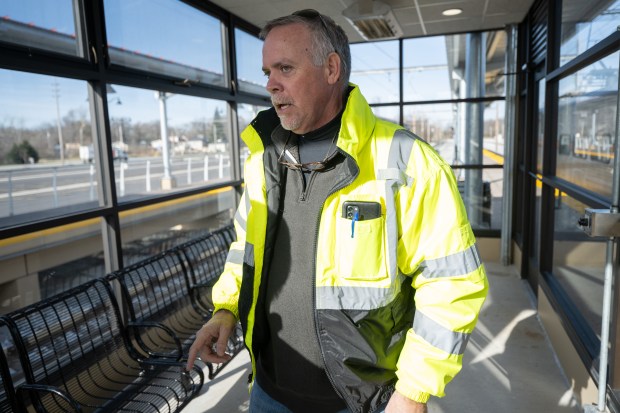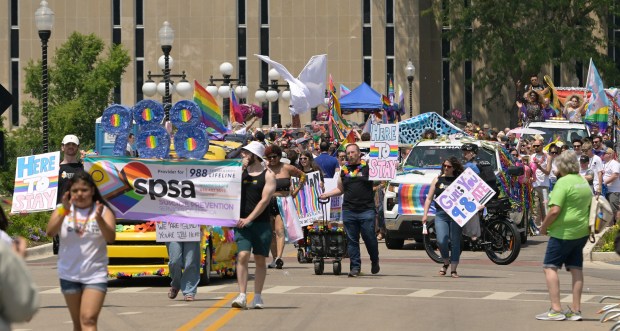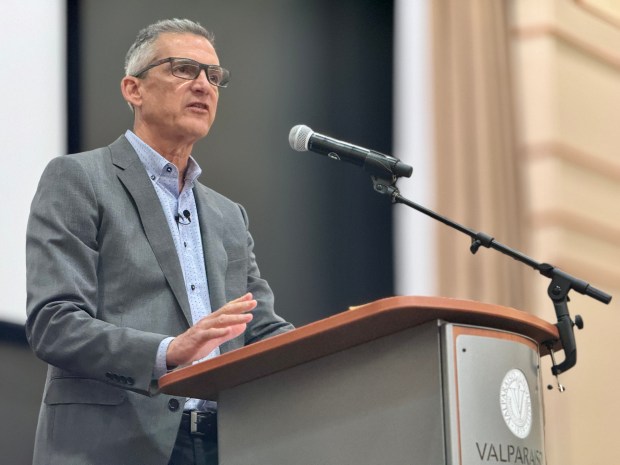It’s taken two years of construction, plus about two years before that to move utility lines in preparation for construction, and years before that to plan the project, obtain funding from state, local and federal governments, seek bids, get new bids when the first ones were too high, and award contracts.
Soon, the South Shore Line’s Double Track project between Gary and Michigan City will be completed, and trains will start running on the railroad’s entire route between Chicago and South Bend.
Several of the railroad’s officers led a ride recently along the rebuilt route to point out some of the changes the project will bring.
Faster trains, for one.
Before, with a single set of tracks for all but about 6 miles of tracks between Gary and Michigan City, a train would have to pull over onto a siding when a train approached from the other direction.
“Dwell time, waiting for another train – that’s all gone,” said Mark Fleming, the railroad’s assistant superintendent of transportation.
With the new tracks, he added, “We get to 79 (miles per hour, the top speed) a lot faster.”
The new tracks also have crossovers so a train going in one direction can switch to the other track if there’s a problem on the first track.
And the ride is smoother with new rails along the 26-mile Double Track route, construction manager Jeff Dekker said.
As the westbound train left Michigan City’s Carroll Avenue station Tuesday, it ran along a single track until it crossed Michigan Boulevard.
“Now we’re in Double Track territory,” Dekker said, as the train began running along what used to be 11th Street.
Until Double Track construction began a little more than two years ago, South Shore Line trains shared 11th Street with cars and trucks. The vehicles ran on either side of the railroad’s single set of tracks, which were embedded in the pavement.
Now 11th Street is a one-lane road, only for eastbound vehicles, and the train’s two sets of tracks have taken over the former road.
The Double Track project reduced a curve in the tracks at Lafayette Street to make the ride smoother and quieter, Dekker said.
Twenty street crossings in Michigan City have been closed for the new tracks, Double Track project manager Nicole Barker said. Some are being made into cul-de-sacs.
Crossing gates, to stop vehicles when a train is approaching, have been erected where the remaining streets – including Franklin Street, Michigan City’s main north-south road – cross the tracks.
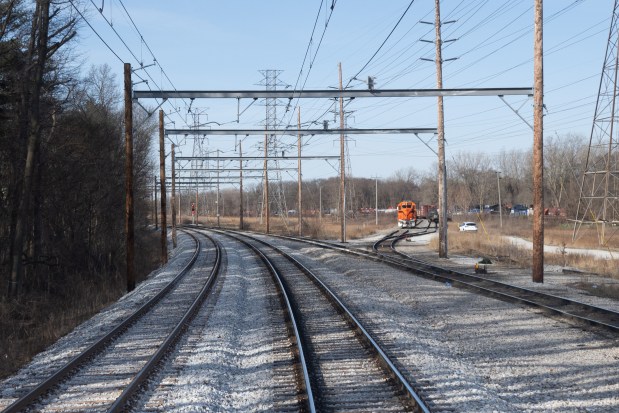
Barker pointed out two additional protections on those streets: crossing gates for pedestrians as well as vehicles, and a concrete median in the middle of each street on either side of the crossing, to keep vehicles from driving around the crossing gates.
With the additional crossing protection, Michigan City has applied to the Federal Railroad Administration for a quiet zone so trains don’t sound their horns at each crossing, nearly all of them in residential neighborhoods.
Barker expects the quiet zone to be approved soon by the FRA.
The station at Franklin and 11th streets will be Michigan City’s main South Shore Line station, but now it’s just two high-level platforms.
Construction began only recently on the station building and the 436-space parking garage that will be attached to it.
The station is to be finished by the end of this year, Barker said.
The 11th Street station is being built by Flaherty & Collins Properties, developers of the adjacent 12-story building also under construction at 11th and Franklin streets. It will include 220 apartments and ground-level stores, the developers say.
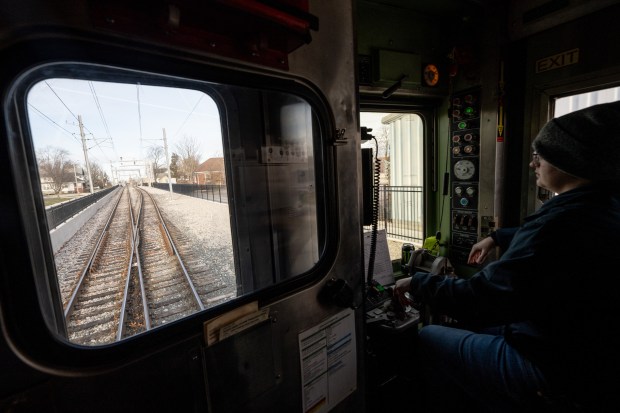
The new station there will have a familiar look, as the façade will be the terra-cotta tiles from the face of the old 11th Street station. They were taken off the old building before it was demolished.
While the new station and its parking garage are being built, Barker said, the city has set aside a comparable number of parking spaces on nearby streets and lots so riders can use the station’s platforms.
As the train rolled into Michigan City’s west side, Barker pointed out the South Shore Line’s intersection with tracks for Amtrak trains running between Chicago and Michigan.
The diamond-shaped interchange there had to be installed without interrupting Amtrak’s service, Barker said, so the work was compressed into a four-hour window late one night.
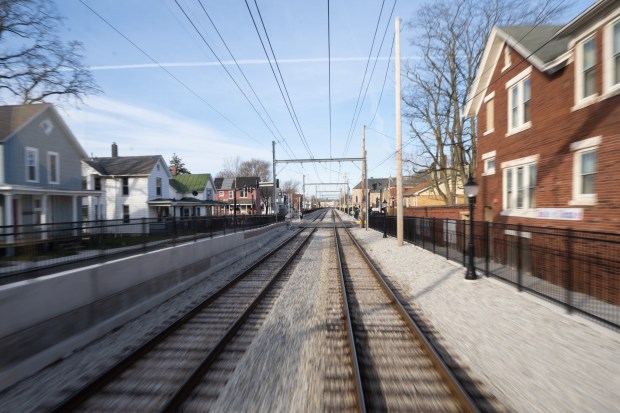
Between Michigan City and the Dune Park station, the South Shore Line installed four oversized culverts for ditches running under the tracks.
Barker said officials at Indiana Dunes National Park, which sits on both sides of the tracks for a stretch, insisted on the larger culverts because of concern that storms resulting from climate change would increase the water flow.
In the town of Pines, Brown Ditch crosses under the tracks through three 6-foot-wide culverts instead of the previous single 4-foot-wide culvert.
The inside of one of the culverts has a platform so wild animals can cross safely under the tracks. Barker said some people have seen animals using the wildlife shelf already.
As the train neared the Cleveland-Cliffs steel plant in Burns Harbor, Barker pointed out where tracks used by the South Shore Line have been separated from the tracks for the Chicago South Shore and South Bend Railroad, a freight railroad.
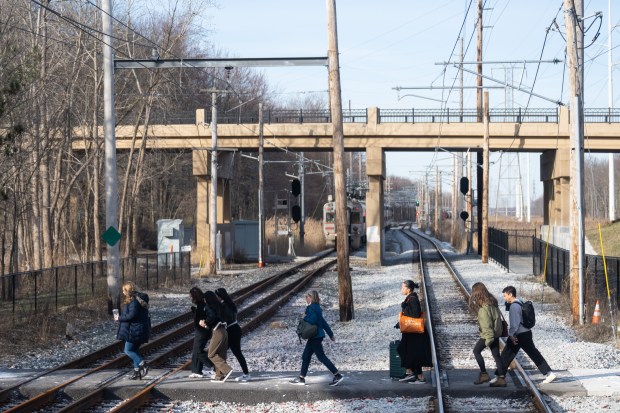
The freight tracks used to run on either side of the South Shore Line tracks there.
“Now they’re out of our hair,” Barker said.
As the train crossed a new bridge over the Norfolk Southern Railroad near Cleveland-Cliffs, Barker said the bridge’s construction had to be compressed into 30-minute increments because the freight tracks are some of Norfolk Southern’s busiest.
The Portage/Ogden Dunes station has two new high-level platforms and 542 parking spaces, 363 of them in a new parking lot south of U.S. 12.
The high-level platforms make boarding trains faster and easier, particularly for passengers in wheelchairs.
The pedestrian crossing over U.S. 12 to and from the south parking lot there includes an on-demand traffic signal to stop traffic on the highway, Barker said.
Two of the Double Track Project’s four new bridges were built near the Cleveland-Cliffs plant. The two others were built a little east of the Miller station, parallel to the older bridges.
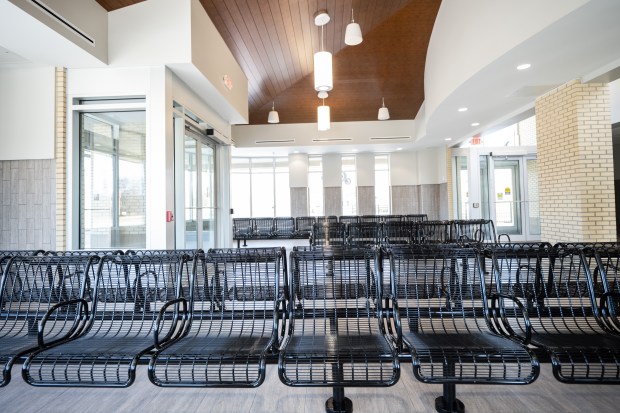
The second set of bridges at Miller is a time-saver, Fleming said.
“We had to wait there a lot,” he said.
The new Miller stop includes two 800-foot-long boarding platforms with shelters, and its spacious station will include a snack bar as well as ticket-buying machines.
Miller has parking spaces for 732 vehicles, including 287 in a lot east of Lake Street, behind the McDonald’s restaurant.
The Double Track project was the first time Dekker, who previously worked on projects to build hospitals and schools, worked on a railroad project.
Were there many delays or unexpected problems?
“No more than usual,” he said. “Overall, it’s gone really well.”
Tim Zorn is a freelance reporter for the Post-Tribune.


